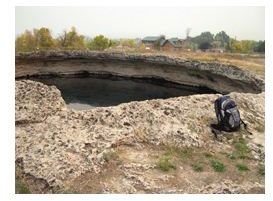How is Geological Energy different than Biological Energy?
Geological Energy
Geological energy can be seen in nature in several forms, with one of its common manifestations being earthquakes, which really happen under the earth’s crust in the form of tectonic plate movement.
An abrupt energy release in the crust causes the creation of tremors or seismic waves in an earthquake.
The amount of this tectonic energy, which is released as mechanical energy, depends on the strain built up, the mass of the area, and the waves’ acceleration.
Energy thus released can pose a severe threat to mankind by damaging and destroying property and living things.
Image Credit: geology.utah.gov
Biological Energy
Biological energy evolves from the sun and is stored in animals and plants in the form of chemical energy as atom bonds in different molecules. Solar energy is converted into chemical energy by plants, and animals obtain it from the plants. The process of energy conversion from one form to another in living beings is also known as metabolism.
The biological definition of energy thus includes that which exists in living and biological organisms and is vital for the survival of living beings.
Biomass energy, however, is quite different from both energy forms and should not be confused to be the same as biological energy. Biomass is basically a renewable energy resource, and this form of energy is extracted from biological materials present in microorganisms, living beings, and other wastes. It can be used to generate electricity or produce heat and to supplement conventional energy sources.
Hydraulic power or hydroelectric energy is one of the most common forms of renewable energy being used these days. Since it’s generated from the power of falling water, it’s not classified under biological energy.
Similarities and Differences between Geological and Biological Energy
When considering the similarities, nothing striking is in common, but still the basic aspects are comparable.
- Both are a form of energy and entail exothermic processes.
- There is some action occurring in both during their translation to other energy forms and transfer from entity to entity.
- The existence of both these is in our solar system and their source is chiefly a heavenly body.
- The sun is the prime source of biological energy, while the earth is the actual source of geological energy.
When you try to analyze how geological energy differs from biological energy, the following noteworthy differences are apparent.
-
Geological energy is derived from nature. (It need not be earthquakes necessarily; it can also include tornados, ocean waves, lightning strikes, etc.) Biological energy is drawn from living beings like microorganisms and plants.
-
The former energy type offers immense economic value for mankind. For instance, they are the original resources for oil sands, petroleum, natural gas, geothermal resources, and oil. By far, the derivation of biological energy from living beings is an attempt to transform this energy for converting, storing, and using it for constructive purposes.
-
As the geological energy within the crust increases, earthquakes are caused, leading to heavy losses to human beings. So, efforts are taken to tap this energy for other useful purposes, which may actually reduce the chances of earthquakes.
-
On the other hand, biological energy is not life threatening. Since it is drawn from living beings, it contributes significantly to reduce greenhouse gases. It is also an eco-friendly solution to industrial pollution related problems. Several measures have been undertaken to make use of biological energy in order to produce petrol for automobiles.
Need of the Hour - Save Conventional Energy Sources!

Having seen all the differences, it is important to know that increased usage of geological resources has led to its scarcity. This directly has an impact on the increasing prices of gas, petrol, etc., leading to high inflation. Although there are efforts underway to reuse or renew this energy, biological energy- in the form of renewable resources rather than fossil fuels- is considered as a more effective solution to this problem.
Finally, it is all not just about using these resources to reduce pollution and other hazardous effects. It is the responsibility of each and every individual to realize the need for energy conservation and contribute significantly towards it.
And, of course the best way is to make more use of renewable forms of energy, reduce the consumption of electricity, gas, and fossil fuels, and take every possible step to ensure that the upcoming generations are left with ample supply of conventional energy sources to lead a normal life. (Can you even imagine a day without petrol and gas? Ouch!)
Even solar and wind energy is being harnessed extensively these days to address this issue and to reduce the rate of depletion of conventional energy sources.
